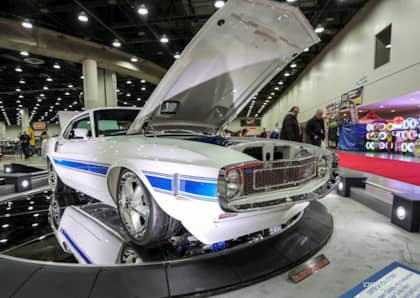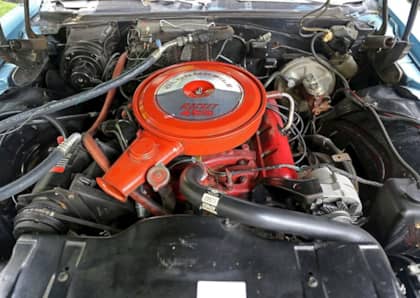The Hurst Lightning Rods Shifter System Was The Craziest '80s Transmission Tech Ever Built
Any time you add more than a single stick to a vehicle's gear selector, you're breaking with nearly a century of automotive tradition. Although early cars and trucks used a variety of different interfaces to activate their various transmission designs, and modern automatics incorporate buttons and dials, the use of a stalk on the steering column or a stick jutting up from the center console was the default for both manual and auto gearboxes for decades.

This makes any company that breaks with that tradition stand out in the annals of history, particularly if the designer is a major name in the transmission business that probably should have known better. A perfect example? The Hurst Lightning Rods, perhaps the strangest automatic transmission option ever sold on a 1980s muscle car.
Not Quite Sequential Shifting
Sequential shifting—where gears are accessed one after the other—has often been favored by drag racers for the economy of motion associated with moving a stick in a straight line while accelerating down the quarter mile. All manner of gear selectors dedicated to providing this type of quick-and-easy gear shift (whether for an automatic or a manual transmission), have been developed over the years for both cars and of course motorcycles (where sequential gearboxes are commonplace).

Hurst had explored bringing this kind of speedy sequential shifting to the street during the golden age of the muscle car with the 'Dual Gate' shifter. Debuting at the end of the 1960s in the Hurst/Olds muscle car, the design featured a second shift gate to the right of the standard PRND markings that, when the shifter was moved over, allow for the first three gears to be rattled off, one after the other, by pushing it forward. Hurst also boosted transmission line pressure when the second gate was in use, and at full throttle each shift was brutally quick compared to the more languid action when the car was left in Drive.
Three Is Better Than One
In the early 1980s the Hurst/Olds pairing was still a going concern. With muscle glory in the rearview, however, the transmission company needed to come up with a new gimmick to make the G-body Cutlass attractive to performance fans. This was the genesis of the Lightning Rods, a trio of shifters that somehow managed to complicate what the Dual Gate had achieved, all in the name of 'simplifying' straight line speed.

Looking in through the window of the 1983 Hurst/Olds was a prescription for confusion. Sprouting from the center console were a trio of unequal-length chrome 'Lightning Rods,' placed side-by-side where one would expect to find a single shifter shaft. If buyers were able to get past that particular slice of cognitive dissonance, they were greeted with a section of the car's owner's manual that described how to operate the strange setup.

If normal cruising was desired, then the two farthest levers could be pushed to their forward position, and the stalk closest to the driver could be shifted from Park to Overdrive and left there for the transmission to do its thing. When it was time to get the blood boiling, however, it was time to tag in the other two shifters.

Moving all three stalks to their bottom positions put the car in first gear. Hammer the gas and at the appropriate RPM move the farthest shifter up to select second gear, then repeat the process with the middle lever to grab third. If you really had a bee in your bonnet, pushing the 'Drive' shifter to 'Overdrive' would do exactly what you'd think it would do. Downshifts, if that was your thing, were done in exactly the reverse order.

What if you tried to shift out of order, or engage an unusual combination of shifter positions? It actually wasn't possible, since all the levers did was move the traditional shift cable on an unmodified version of GM's automatic. It's hard to say if the Lightning Rods actually improved acceleration, but it certain gave drivers something to engage with instead of simply relying on the autobox to handle the shifting duties entirely on its own. It also offered an inexpensive street link to pricier drag racing technology that was being used at higher levels of the sport.
A Short Season
The G-body edition of the Hurst/Olds was only offered for two model years, but Hurst made an effort to spread the Lightning Rod love across other GM products fitted with four-speed automatic transmissions (the Hurst/Olds specifically used a TH200-R4). A conversion kit was offered for popular Buick, Chevrolet, and Pontiac performance cars of the day, including the Camaro and the Firebird, and it was also adapted by a number of gearheads to older automatic-equipped muscle cars from the '60s and '70s for use in amateur competition. Overdrive wasn't a requirement, either, as the Lightning Rods were just as happy hooked up to a 3-speed as a 4-speed.

Still, Lightning Rods never really caught on with the hot rod crowd past those who were intrigued by its curious design. Ratchet shifters were seen as an easier and less fussy way to get maximum performance out of an automatic transmission, and quickly colonized the drag racing world.

By the end of the 1980s manual controls over automatics were becoming considerably more sophisticated thanks to computer controls, which also contributed to the waning popularity of the Lightning Rods. Still, for a brief moment in time this unusual auto-shift setup made a splash during a decade where automotive performance was just starting to find itself again after a long decade wandering the Malaise Era wilderness.











